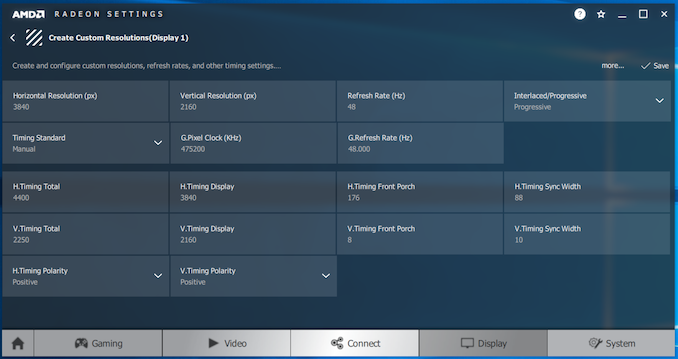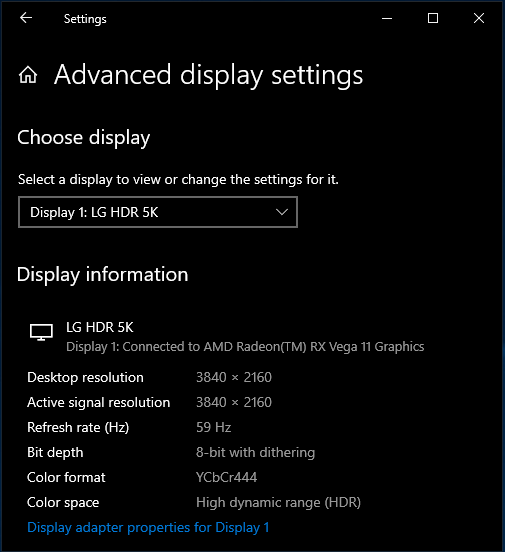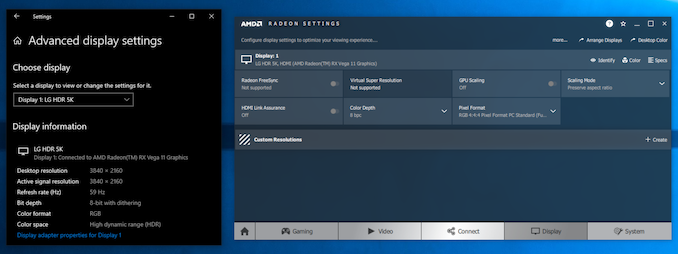The ASRock DeskMini A300 Review: An Affordable DIY AMD Ryzen mini-PC
by Ganesh T S on April 26, 2019 8:00 AM ESTHTPC Credentials - Display Outputs Capabilities
The
| ASRock DeskMini A300 Display Outputs | |||
| HDMI | DisplayPort | VGA | |
| Version | 2.0a | 1.2 | N/A |
| Max. Video Output | 3840x2160 @ 60Hz | 4096x2160 @ 60Hz | 2048x1536 @ N/A |
| HDCP | Yes (2.2) | N/A | |
| HDR | Yes | No | No |
| HD Audio Bitstreaming | Yes | N/A | |
Supporting the display of high-resolution protected video content is a requirement for even a casual HTPC user. In addition, HTPC enthusiasts also want their systems to support refresh rates that either match or be an integral multiple of the frame rate of the video being displayed. Most displays / AVRs are able to transmit the supported refresh rates to the PC using the EDID metadata. In some cases, the desired refresh rate might be missing in the list of supported modes.
Custom Resolutions
Our evaluation of the
We tested out various display refresh rates ranging from 23.976 Hz to 59.94 Hz. Of particular interest is the 23.976 Hz (23p) setting.
The gallery below presents screenshots from the other refresh rates that were tested. The system has no trouble maintaining a fairly accurate refresh rate throughout the duration of the video playback.
High Dynamic Range (HDR) Support
The ability of the system to support HDR output is brought out in the first line of the madVR OSD in the above pictures. The display / desktop was configured to be in HDR mode prior to the gathering of the above screenshots.
By default, the DeskMini A300 drives a YCbCr 4:4:4 signal to the display in HDR mode. This is in contrast to the sub-samped (4:2:2 or 4:2:0) formats used by other GPUs. 4:4:4 ensures that the desktop doesn't have any chroma sub-sampling artifacts leading to fuzzy display of text content. The Readeon Settings application allows for easy configuration of any desired pixel format. We were also able to configure a RGB 4:4:4 full level signal (0-255) in the HDR mode.
AMD systems do not support the Software Guard Extensions (SGX) feature needed to play back UHD Blu-rays. Hence, we didn't bother running the CyberLink UHD Blu-ray Advisor Tool in the DeskMini A300.




















88 Comments
View All Comments
abufrejoval - Friday, April 26, 2019 - link
Very nice review!But surprisingly little relative change (relative to publicity...) from the previous (major) iteration, which I interpret as the Kaveri vs. Skylake Iris Plus that I own and tested, A10-7850k vs. i5-6267U.
Intel still seems to never use more than 15Watts for the CPU, yet manages scaling single to 4GHz at great IPC while it manages to sustain admirable Hertz even at multi-core constant loads, taking a nice sip of cool on every little stall. AMD seems to retain a much more linear efficiency curve where clocks and cores just eat power, while the difference at the wall plug is much smaller in this iteration (was 3:1 for exactly the same performance on my old systems).
The good thing is that on a device like this, peak power is much less important than on a notebook, so it’s ok, as long as maintains quiet on constant peak and (finally) reaches acceptable idle: Here I see a lot of progress on AMD's side, Intel has much less room to beat itself.
For graphics, bandwidth is so crucial and I wonder what the AMD could do with a bit of eDRAM, HBM or even a lower-power variant of GDDR5… but I guess the latency issues could kill browser performance and that is unfortunately a large chunk of what buyers would want these for…
Still dreaming of a way to put well-proportioned APUs in a scalable system with 1x/2x/4x configs… With storage and RAM no longer eating box space, 75/150/300 Watt configs could be relatively small yet remain quiet.
Speaking of idle power and quiet, this is where I get interested in the AMD. The NUC is great in everything but noise on peak load, but it would really only take a replacement top and a Noctua to make it great… There is so much space behind these giant 4k screens, nuc/NUC can become a little pointless.
Good Linux support is where I am getting concerned. Current reports praise AMD on their Linux vision… but progress seems a very different story and one where Intel (sorry Charly), really shines, even Nvidia seems better in practical terms (sorry Linus). I’m also somewhat disheartened by power management there: Not sure I’ll be able to reach 10 Watt of idle on CentOS or Ubuntu *and* Steam/Vulkan performance comparable to Windows (it’s actually gotten quite good on bigger Nvidia GPUs, even GPU pass-through to a Windows VM is kind of fun).
sor - Saturday, April 27, 2019 - link
As I mentioned probably as you were typing this, I ran Ubuntu straight out of the box and am getting nearly 50% better FPS than this review on Dota 2. Full vulkan support and max settings. Pleasantly surprised, I am used to having to tinker with drivers.Notably, I don’t think this would have been possible 8 months ago as only newer kernels have the good AMD support built in.
Pishi86 - Saturday, April 27, 2019 - link
This is not exactly a fair comparison. You are comparing a desktop AMD chip with and a mobile Intel chip. Its kind of like comparing an i3 8100 vs a Ryzen 5 3500u. AMD's Ryzen 5 3550H and Ryzen 7 3750H would have been more competitive. These chips are about as fast as the 2400G, but with an maximum TDP of 35w. There are some reviews on Notebookcheck and these chips are consuming just over 70w underload. This is with a 15.6 1080P screen and a power hungry Radeon RX 560X. The power consumption and battery life is actually better than an i5 8300H and 1050 combo with an identical. Check out the review below.https://www.notebookcheck.net/Asus-TUF-FX505DY-Ryz...
The truth is the onboard Vega on Ryzen is a very powerful iGPU held back by memory bandwidth. Unrestrained, its probably 80-90% as powerful as an RX 460. It has 640-704 Vega cores which are clocked higher (1.2-1.4GHz) than the 896 cores in the RX 460. Vega's IPC should be a bit above Polaris's.
I agree with you Linux support is spotty, I am a Linux user myself and I am in the market for a new laptop, but I may have to buy Intel despite its weak iGPU. Unfortunately, you can't find anymore Iris powered laptops these days (outside the macbook pro). Also, even though its improved AMD's video decode/encode is not as efficient as Intel's. I am not even sure if Nvidia is as efficient as Intel in video playback. Having that said I would not trust Intel's UHD graphics powering a 4k monitor, which is what I am in the market for.
Pishi86 - Friday, April 26, 2019 - link
Does anyone know if you could get a 3rd party power supply that's more than 120w? I mean 150w might be good, if AMD releases 95W APUs in the future. A 120W PSU might limit CPUs abover 65W.Lucky Stripes 99 - Sunday, May 5, 2019 - link
Yes, there are third party power bricks available that can supply more current. Just keep in mind that the power regulators on the motherboard may not be rated for that higher current and that you could shorten its life or run into stability issues if you attempted to use a more power hungry processor (assuming if the BIOS would even make it past POST with an unsupported processor).Haawser - Saturday, April 27, 2019 - link
Good luck buying one...Only EU retailers I could find seem to have sold out within hours. Still, will keep trying. As this is exactly the sort of SFF I've wanted since Ryzen APUs came out.ganeshts - Saturday, April 27, 2019 - link
On Amazon and Newegg, Computer Upgrade King seems to have lot of ready-to-go models with the DeskMini A300 ; Eg: https://www.newegg.com/Product/Product.aspx?Item=9... (Just FYI - I have no idea about the reputation of this retailer. Just came up during my search on Google)Haawser - Saturday, April 27, 2019 - link
@ganeshts- Again, out of stock. Personally I think ASRock, Lenovo, HP, Zotac and everybody else that manufacturers SFF PCs have greatly underestimated the number of people looking to buy Ryzen APU based systems. And with the improved 3000 series (12nm Zen+ with soldered HS) soon available, the barebones will be even more sought after.ganeshts - Sunday, April 28, 2019 - link
Shows in-stock for me when I added to cart : https://i.imgur.com/YWbYlJ6.pngoliwek - Saturday, April 27, 2019 - link
For people in NL or BE, I bought mine from here, delivered promptly : https://www.megekko.nl/product/2321/237330/Barebon...